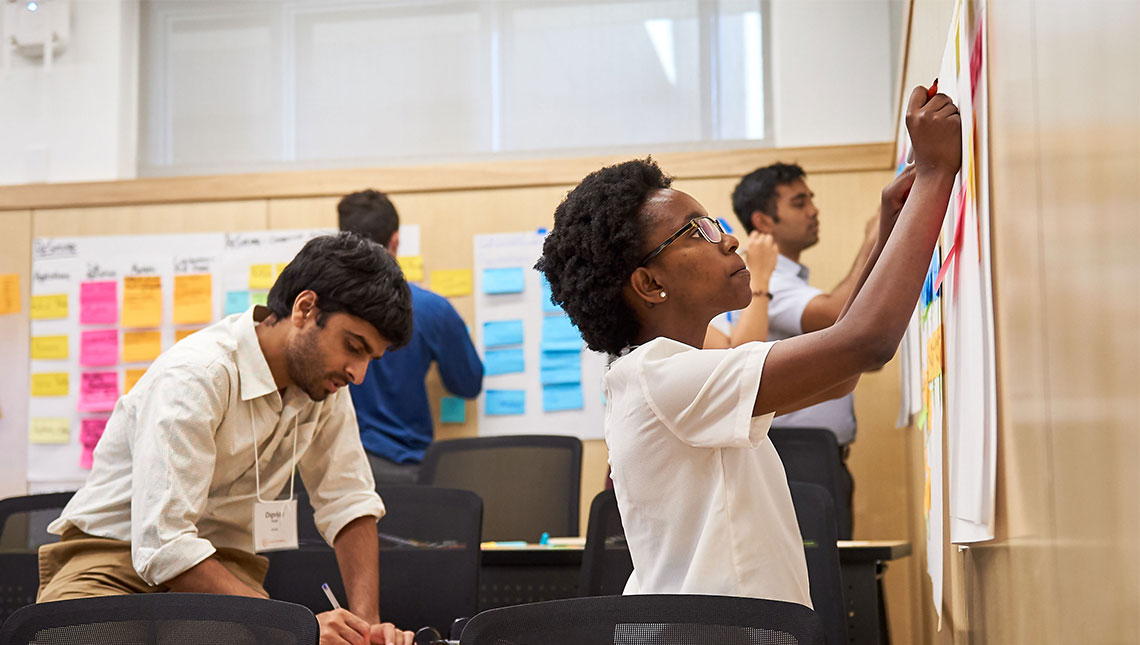
In a study published by Proceedings of the National Academy of Sciences (PNAS), the authors concluded that using an active learning approach can help improve students’ grades—for some students a full letter grade higher by the end of the semester. While assignments that encourage active learning are an effective way to increase student performance and engagement, we know it can be challenging to find the right exercises to incorporate into your curriculum.
We’ve asked some of our faculty grantees to share their active learning activities that you can use to help refine your own coursework for maximum impact.
7 Active Learning Classroom Activities
 Team Update Activity
Team Update Activity
Sophi Martin, formerly at the University of California-Berkeley Blum Center for Developing Economies
“A key exercise in my courses is the team update. Each team gives a weekly status report to the class, and the rest of the class asks questions and offers suggestions. The process encourages students to support one another in the development of their ideas, and build a sense of psychological safety across the cohort. The reporting also keeps the teams honest, not just with the instructors, but with themselves.”
 Capturing Customer Feedback Activity
Capturing Customer Feedback Activity
Robbie Nock, ArtCenter College of Design
“The most important activity for students in our Launch Lab program is capturing clear, actionable feedback from potential customers and users. Students tend to have a wide range of prior experience in gathering this first-hand research. We start with Strategyzer’s Ground Rules for Interviewing to develop technique and create an outline for interviews. Students then test this on campus with fellow students, faculty, and staff, practicing and refining their questions before contacting interviewees in the market that they seek to enter. Prototyping their interview technique in this way compliments the iterative product development process as they work towards demonstrating viability and market fit.”
 Service and Professional Development Activity
Service and Professional Development Activity
Dustyn Roberts, University of Pennsylvania
“I have recently started using a few percentage points of the grade for my classes for service and professional development. The students can earn these points in a wide variety of ways, from helping their peers through in-class activities to attending job fairs or events. The deliverable for each assignment is to 1) demonstrate they were there or did the thing they claim (typically a selfie in front of an event sign or a sign-in sheet), 2) describe the service or professional development activity, and 3) write a short paragraph on their reaction to the event. Reading these reactions has been fascinating, and in some cases has led students to new interests and career opportunities they might not have otherwise sought out. It’s kind of a hack to encourage intrinsic motivation with extrinsic rewards.”
 The Ram Rumble Activity
The Ram Rumble Activity
Scott Shrake, Colorado State University
“I co-developed an activity with my colleague Brent Sebold at Arizona State University that I’ve termed “The Ram Rumble.” This immersive, fast-paced activity has students take a concept from idea to product in a very short period of time. We go through the basics of problem identification, pain point validation, customer discovery, human centered design, prototype development, user feedback, prototype iteration, and a final pitch—all in less than 8 hours. It enables the students to recognize how all of those concepts are essential to create a valuable product, so they have context as we dive deeper into each concept throughout the program. The activity also shows students that prototypes don’t have to be perfect, time isn’t always on your side, and getting out of the classroom is invaluable.”
 Market Scour Activity
Market Scour Activity
Khanjan Mehta, Lehigh University
“Every activity in my class is designed to directly support interdisciplinary teams in advancing their multi-year ventures. For example, when we are out in the field conducting research and building social ventures, I make my students scour the market and find the going price for an item from 20+ vendors. They often spend two days just walking around and talking to vendors and come back with valuable information—and skills. They learn how to communicate across linguistic and cultural barriers, build relationships, negotiate, gather new design ideas from vendors, and learn some humility. Most importantly, they become confident in their ability to navigate a new space. And yes, most figure out how to pay lower than the locals do.”
 Systems Mapping Activity
Systems Mapping Activity
Nordica MacCarty, Oregon State University
“I’m using the systems mapping exercise that I learned about from Jeremy Faludi during the VentureWell faculty development workshop. It’s an excellent way to help students think about a problem more holistically.”
 Basic Labs Skills Activity
Basic Labs Skills Activity
Marc Facciotti, University of California-Davis
“Our student-run BioInnovation Group organizes basic skills-training activities to help onboard anyone who is interested in developing new lab skills. One skills-training activity involves a small competition in which students are asked to complete a number of measurement tasks that require them to find and use (while getting trained) various pieces of equipment in the laboratory. They learn how to accurately measure and transfer different types of liquids, learn how to make complex mixtures, find various mixing and sample collection tools, and learn how to operate various commonly used instruments along the way. They collect and analyze data and compare their results against those of an expert. The person(s) that best match the expert win a small prize.”
For many students, their first exposure to innovation and entrepreneurship happens in your classroom. That’s why it’s important to adopt activities that support active learning to better prepare students to launch a journey to solve the world’s biggest problems through innovation and entrepreneurship.
How do you determine what resources student inventor-entrepreneurs need—and when? Use our Venture Development Framework to help inform the development, implementation, and evaluation of programs supporting early-stage innovators.
Looking for more classroom exercises? Check out these resources:
8 class activities to stimulate inventor entrepreneurs